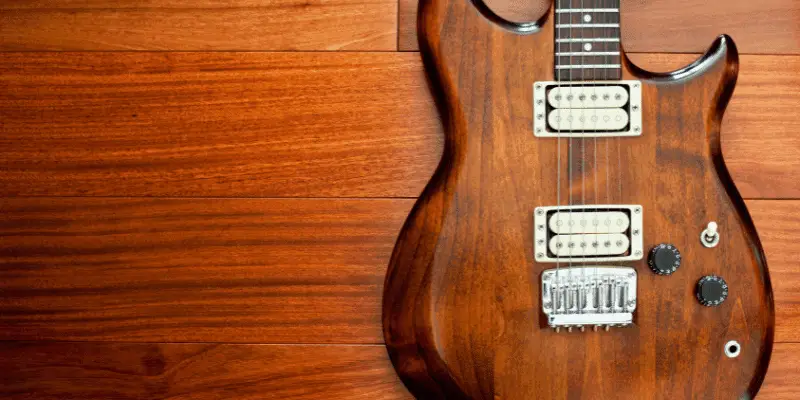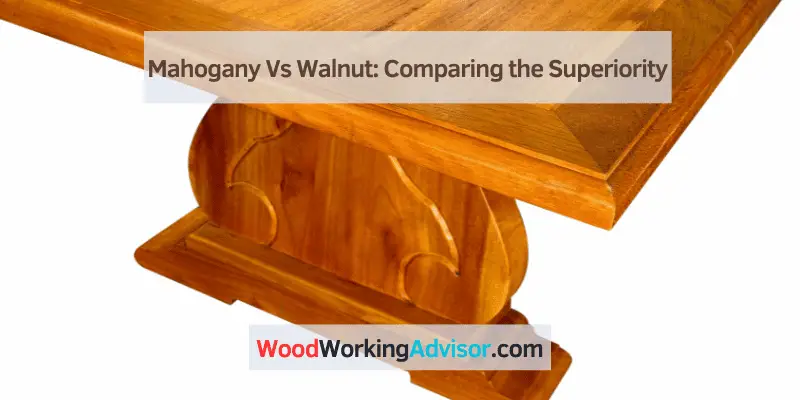Mahogany and walnut are both popular choices for furniture due to their durability and aesthetics. Mahogany has a reddish-brown color with a fine grain, while walnut has a rich brown color with a prominent grain pattern.
Each wood has its unique characteristics, making them suitable for different styles and preferences. Understanding the differences between mahogany and walnut can help you make an informed decision when choosing furniture or woodwork for your home or office. We will explore the distinct features of mahogany and walnut, including their physical attributes, qualities, and common uses.
Whether you’re a homeowner, designer, or woodworking enthusiast, learning about these two versatile woods can enhance your understanding of their practical and aesthetic value.
Understanding Mahogany And Walnut
Mahogany and walnut are both popular choices for furniture due to their rich colors and durability. While mahogany boasts a reddish-brown hue and a higher price tag, walnut offers a darker, chocolate-brown color and a more affordable option. Understanding the differences between the two can help you make an informed decision when choosing wood for your next project.
Mahogany and walnut are two popular hardwoods used in furniture and cabinetry. Each wood has its own unique characteristics and appeal. Understanding the differences between mahogany and walnut can help you make an informed decision when choosing between the two for your woodworking projects.
Characteristics Of Mahogany
Mahogany is a tropical hardwood known for its rich, reddish-brown color and straight grain. It is a durable and stable wood that is often used in high-end furniture and musical instruments. Here are some key characteristics of mahogany:
– Color and Grain: Mahogany features a deep, lustrous red-brown color with a fine, straight grain that gives it a luxurious appearance.
– Durability: It is a durable wood with excellent dimensional stability, making it resistant to warping and swelling.
– Workability: Mahogany is relatively easy to work with and can be carved, shaped, and sanded to a smooth finish.
– Uses: It is commonly used in fine furniture, interior trim, boats, and musical instruments.
Characteristics Of Walnut
Walnut is a domestic hardwood known for its rich, dark brown color and distinctive grain patterns. It is prized for its warmth and character, making it a popular choice for furniture and cabinetry. Here are some key characteristics of walnut:
– Color and Grain: Walnut ranges from light tan to dark chocolate brown with pronounced grain patterns that vary from straight to wavy or curly.
– Durability: Walnut is a strong and durable wood that resists shrinking and warping, making it suitable for a wide range of applications.
– Workability: Walnut is relatively easy to work with and can be shaped, carved, and finished to a smooth, lustrous surface.
– Uses: It is commonly used in high-end furniture, flooring, gunstocks, and decorative veneers.
In summary, mahogany and walnut are both prized for their beauty, durability, and workability. Understanding the unique characteristics of each wood can help you choose the right material for your woodworking projects.
Durability And Strength
The durability and strength of wood are crucial factors to consider when selecting the right material for your furniture or woodworking projects. Mahogany and walnut are two popular choices known for their exquisite beauty and remarkable properties. In this section, we will delve into the comparison of the durability and strength of mahogany and walnut to aid in making an informed decision.
Comparing The Durability Of Mahogany And Walnut
When evaluating the durability of wood, factors such as resistance to decay, insect attacks, and overall longevity are critical. Mahogany, known for its exceptional durability, boasts a natural resistance to decay, making it an excellent choice for outdoor and high-moisture environments. Walnut, while durable, may not possess the same level of resistance to decay as mahogany. However, when properly maintained and treated, both woods can exhibit impressive longevity.
The strength factor in Mahogany Vs Walnut
html
The Strength Factor In Mahogany Vs Walnut
In terms of strength, mahogany is esteemed for its impressive sturdiness and density. This wood type exhibits minimal movement and high resistance to warping, making it ideal for furniture construction and high-traffic areas. On the other hand, walnut is recognized for its strength and flexibility, allowing it to be shaped and carved with precision. While both woods offer commendable strength, mahogany may have a slight edge in terms of overall durability and resilience.
In conclusion, when considering durability and strength, mahogany emerges as a robust and long-lasting option, particularly for outdoor or high-moisture applications. Conversely, walnut, though durable and strong, may require extra care in certain environments. Ultimately, the choice between mahogany and walnut should be guided by the specific requirements of your project and the desired aesthetic appeal.
Aesthetics And Finishing
In the world of woodworking and furniture making, the choice between mahogany and walnut often comes down to personal preferences. Aesthetics and finishing play a crucial role in determining which wood to use for a particular project. Let’s explore the visual appeal and finishing characteristics of both mahogany and walnut to help you make an informed decision.
The Visual Appeal Of Mahogany
Mahogany wood boasts a rich, deep, and reddish-brown color that exudes elegance and sophistication. Its straight grain pattern with occasional ribbon-like figuring gives it a timeless and luxurious appearance. The natural luster of mahogany makes it an excellent choice for creating high-end, classic furniture pieces.
The Visual Appeal Of Walnut
Walnut wood, on the other hand, features a darker and warmer brown hue, often tinged with purple or gray undertones. Its grain patterns range from straight to wavy, offering a visually captivating and unique aesthetic. The deep, rich color of walnut wood makes it a popular choice for contemporary and rustic furniture designs.
Applications And Uses
When it comes to choosing between mahogany and walnut for various applications and uses, it’s important to understand the specific industries where each wood type excels. Both mahogany and walnut are highly valued for their durability, aesthetics, and versatility. Let’s explore the common uses of mahogany and walnut in different industries to gain a better understanding of their applications.
Common Uses Of Mahogany In Different Industries
Mahogany, with its rich reddish-brown hue and straight grain, has been treasured for centuries. Its resilience and workability make it a popular choice in various industries:
- Furniture: Mahogany is extensively used in crafting high-end furniture due to its natural luster and resistance to decay.
- Boat building: Its exceptional resistance to rot and moisture makes mahogany a preferred choice for constructing boat parts and decking.
- Door and window frames: Mahogany’s natural durability and resistance to termites and other insects make it ideal for creating long-lasting door and window frames.
- Cabinetry: The wood’s ability to retain its shine and color over time renders it suitable for creating elegant and long-lasting cabinets.
Common Uses Of Walnut In Different Industries
Walnut, prized for its rich chocolate-brown shade, is highly versatile and finds diverse applications across various industries:
- Flooring: Walnut’s strength, coupled with its unique color and grain pattern, makes it a popular choice for high-end flooring in residential and commercial spaces.
- Gunstocks: The wood’s strength, stability, and ability to withstand recoil make it an excellent choice for crafting gunstocks.
- Instrument Making: Walnut’s acoustical properties and rich, warm tones make it an ideal material for crafting musical instruments.
- Cutting boards and kitchen utensils: Its natural hardness and resistance to bacteria make walnut a suitable material for kitchenware and utensils.
Cost And Maintenance
When it comes to choosing between Mahogany and Walnut for your furniture or woodwork projects, considering the cost and maintenance of each wood type is essential. Understanding this aspect can help you make an informed decision that aligns with your budget and maintenance capabilities.
Comparing The Cost Of Mahogany And Walnut
Both Mahogany and Walnut are renowned for their aesthetic appeal and durability, but there are differences in their costs that can significantly influence your decision.
| Aspect | Mahogany | Walnut |
|---|---|---|
| Initial Cost | Higher initial cost due to its rarity and quality | Lower initial cost compared to Mahogany |
| Long-Term Cost | May require less maintenance over time, potentially reducing long-term costs | May require more frequent maintenance, impacting long-term costs |
Understanding The Maintenance Requirements For Mahogany And Walnut
Maintenance plays a crucial role in preserving the beauty and longevity of wooden furniture or fixtures. Here’s a concise overview of the maintenance requirements for Mahogany and Walnut:
- Mahogany: Known for its resistance to rot and decay, Mahogany typically requires minimal maintenance. Regular dusting and occasional polishing can suffice to keep its luster intact.
- Walnut: While Walnut also exhibits high resistance to decay, it may require more frequent maintenance to preserve its rich, dark hue. Regular cleaning and periodic re-oiling are often recommended to maintain Walnut’s innate beauty.
Frequently Asked Questions On Mahogany Vs Walnut
What Are The Differences Between Mahogany And Walnut Wood?
Mahogany is reddish-brown with straight grains, while walnut has dark brown, often with purplish hues, and a more irregular grain.
Which Wood Is More Durable, Mahogany Or Walnut?
Both woods are durable, but Mahogany is more resistant to rot and decay compared to Walnut.
What Are The Popular Uses Of Mahogany And Walnut Wood?
Mahogany is commonly used for furniture and cabinetry, while Walnut is often used for decorative veneers, carvings, and musical instruments.
Is Mahogany Or Walnut More Expensive?
Mahogany tends to be slightly more expensive than Walnut due to its availability and rich color.
Conclusion
Both mahogany and walnut offer unique qualities as wood materials. Consider the specific requirements for your furniture or project to make the best choice. Whether it’s the deep red tones of mahogany or the rich, dark hues of walnut, both types of wood bring their own distinct appearance and characteristics to the table.


